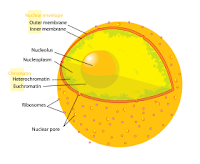 The Cell Wall- The plant cell wall is a remarkable structure. It provides the the most significant difference between plant cells and other eukaryotic cells. This is the outside of the plants structure. It protects the stuff inside of the cell. The cell wall is made up of three layers, which is showed in the picture to the left.
The Cell Wall- The plant cell wall is a remarkable structure. It provides the the most significant difference between plant cells and other eukaryotic cells. This is the outside of the plants structure. It protects the stuff inside of the cell. The cell wall is made up of three layers, which is showed in the picture to the left. Cell Membrane- What makes the membrane so special is the presence of different proteins on the surface, that are used for various functions such as cell surface receptors, enzymes, antigens, and transporters. The cell membrane is very important to the cell because it lets things in and out of the cell. If bad stuff tries to enter the cell its suppose to not let it in.
Cell Membrane- What makes the membrane so special is the presence of different proteins on the surface, that are used for various functions such as cell surface receptors, enzymes, antigens, and transporters. The cell membrane is very important to the cell because it lets things in and out of the cell. If bad stuff tries to enter the cell its suppose to not let it in.Cytoplasm- Cytoplasm is basically the substance that fills the cell. It is a jelly-like material that is eighty percent water and usually clear in color. It is more like a thick gel than a watery substance, but it mixes when shaken or stirred. Cytoplasm, which can also be referred to as cytosol, means cell substance. Cytoplasm is the type of food for the cell.

This is how cytoplasm looks like in real life, it looks more thick than watery.
Vacuole- The vacuole is used only in plant cells. It is responsible for maintaining the shape and structure of the cell. Plant cells don't increase in size by expanding the cytoplasm, rather they increase the size of their vacuoles. The vacuole is a large vesicle which is also used to store nutrients, metabolites, and waste products.
Nucleus- The nucleus is the center part of the cell. It kinda works like the brain. The nucleus has the DNA which gives each cell a different characteristic. The nucleus is the most obvious organelle in any eukaryotic cell.
Chloroplast- Chloroplasts are specialized organelles found in all higher plant cells. These organelles contain the plant cell's chlorophyll, which gives the plant the green color. They have a double membrane.
Mitochondria- Mitochondria provides the energy a cell needs to move divide, move, produce secretory, they are the power centers of the cell.

Ribosomes- Ribosomes are organelles that consist RNA and DNA proteins. They are responsible for assembling of the cell. There are millions of ribosomes in a plant cell.
Golgi Body- The Golgi Body is a membrane- bound structure with a simple single membrane. They are important because they package macromolecules for transport some where else in a cell. These are very important.

|





No comments:
Post a Comment